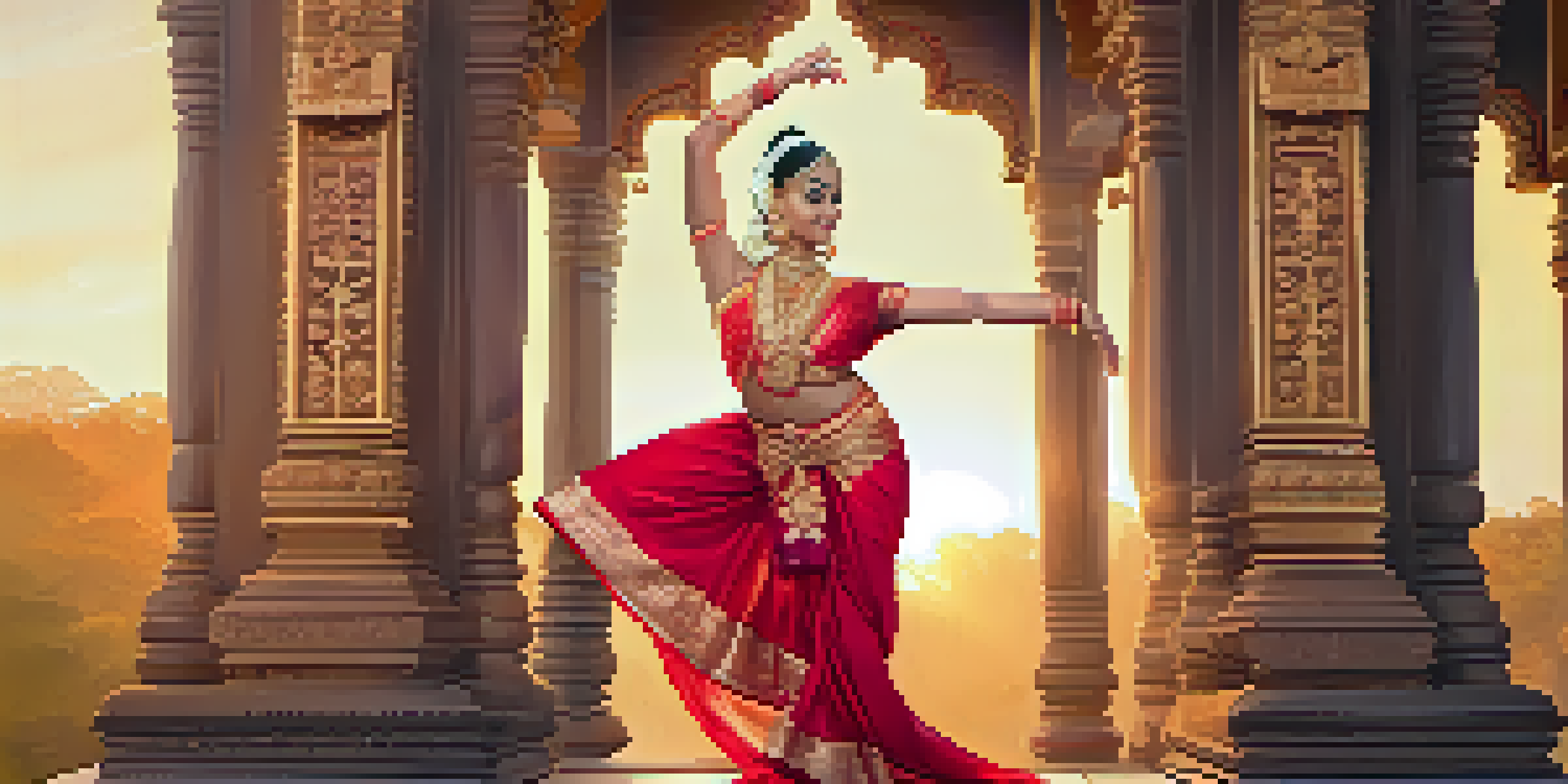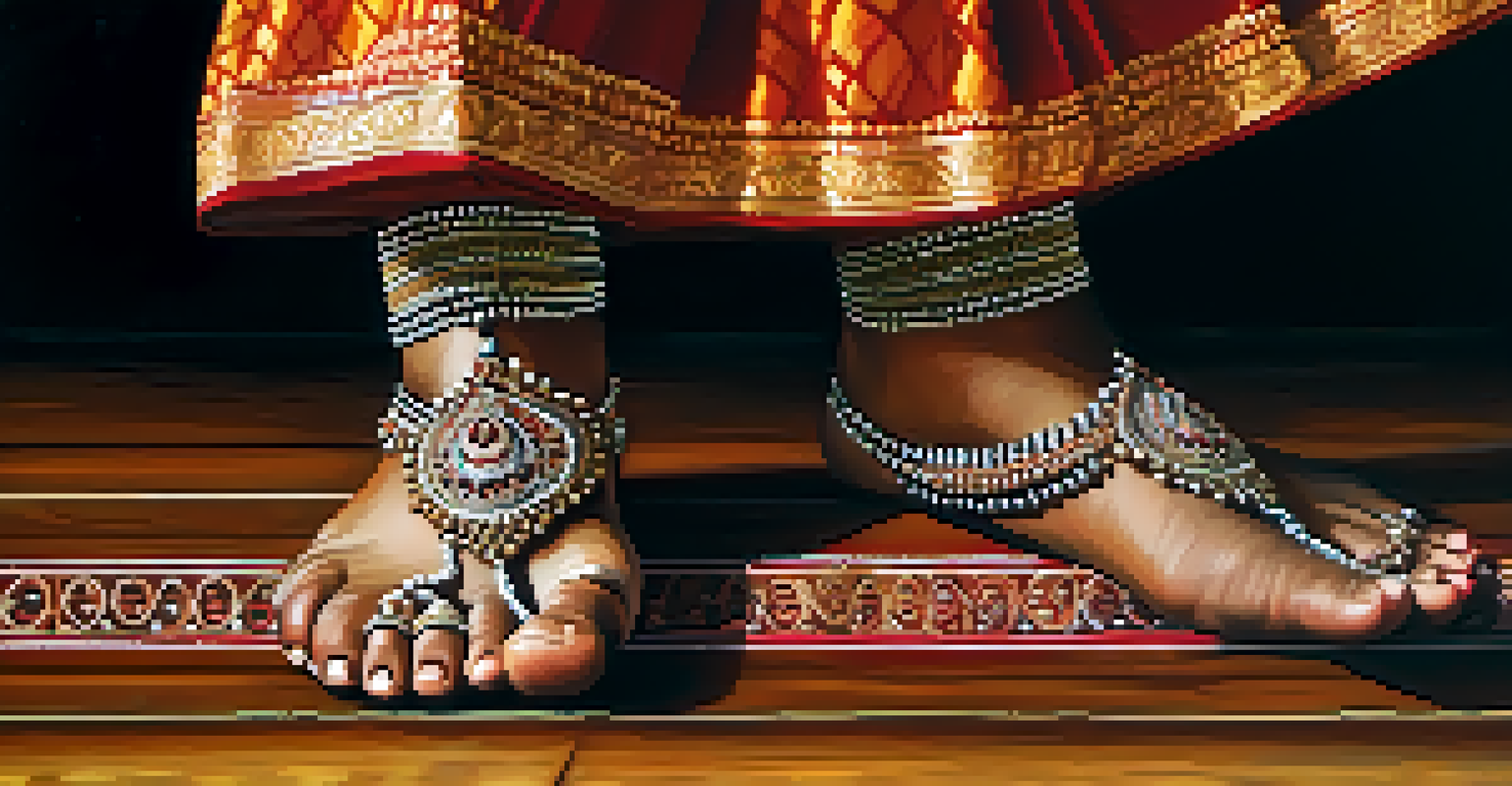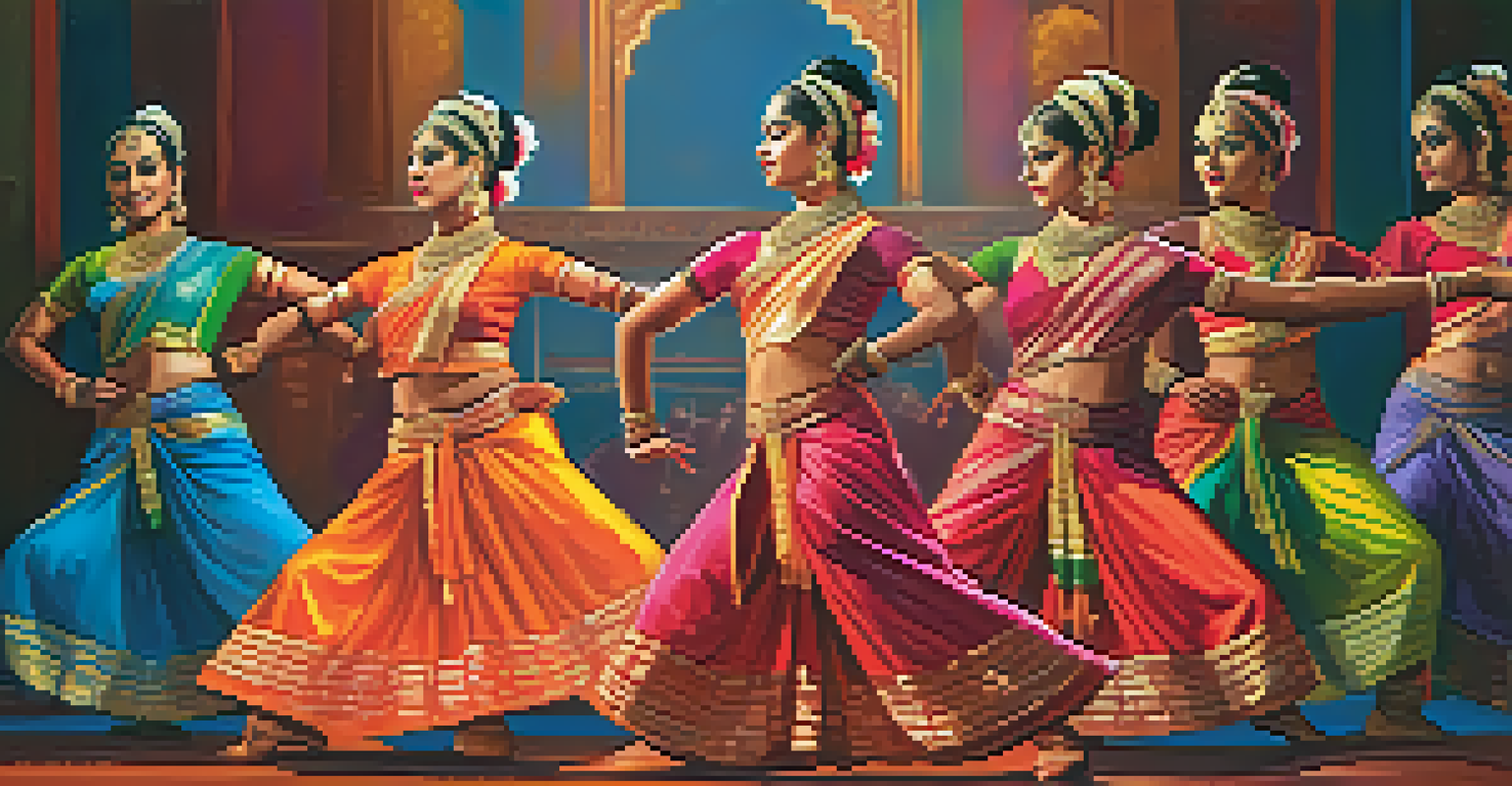Bharatanatyam and Globalization: Preserving Tradition

Understanding Bharatanatyam: A Dance of Tradition
Bharatanatyam is one of the oldest classical dance forms of India, originating from Tamil Nadu. It beautifully combines expressive storytelling with intricate footwork, showcasing a rich cultural heritage. Historically, this art was performed in temples and royal courts, preserving narratives from Hindu mythology. Today, it stands as a symbol of India's diverse artistic landscape, captivating audiences worldwide.
Dance is the hidden language of the soul.
The dance is not just about movement; it's a language of communication, conveying emotions and stories through gestures, facial expressions, and rhythm. Dancers often depict various characters from epics like the Ramayana and Mahabharata, making each performance a journey through mythological tales. This connection to spirituality and tradition is what makes Bharatanatyam unique and revered.
In essence, Bharatanatyam serves as a bridge between the past and present, maintaining its traditional roots while inviting contemporary interpretations. This balance is crucial, especially in a rapidly globalizing world where cultural identities are constantly evolving.
The Impact of Globalization on Bharatanatyam
Globalization has significantly influenced how Bharatanatyam is perceived and performed around the world. With the advent of the internet and social media, dancers from various backgrounds are now sharing their interpretations of this ancient art form. This exposure has led to a fusion of styles, where traditional Bharatanatyam meets modern dance forms, creating exciting new performances.

On one hand, this cross-cultural exchange enriches the dance, introducing fresh perspectives and innovative choreography. On the other hand, some purists express concerns about losing the authenticity and essence of the traditional form. This ongoing dialogue between innovation and preservation highlights the challenges faced by artists today.
Bharatanatyam's Cultural Significance
This classical dance form symbolizes India's rich cultural heritage, intertwining storytelling and spirituality.
Ultimately, globalization presents both opportunities and challenges for Bharatanatyam. As it reaches new audiences, the dance form must navigate its identity, ensuring that while it evolves, it remains anchored in its rich heritage.
Preserving Tradition Amidst Change
Despite the influences of globalization, many Bharatanatyam practitioners are committed to preserving its traditional aspects. Dance schools and cultural organizations play a vital role in teaching the classical techniques and philosophies that define this art form. These institutions emphasize the importance of understanding the historical context and cultural significance behind each movement.
Tradition is not the worship of ashes, but the preservation of fire.
Workshops, performances, and festivals dedicated to Bharatanatyam create platforms for artists to showcase their skills while honoring traditional practices. By fostering a sense of community, these events encourage younger generations to engage with their cultural roots. This connection is essential for ensuring that Bharatanatyam remains vibrant and relevant.
Moreover, teachers often share stories and teachings passed down through generations, instilling a sense of pride and belonging in their students. This commitment to tradition amidst the changing landscape of globalization helps sustain Bharatanatyam's legacy.
Innovations in Bharatanatyam: Embracing New Styles
The beauty of Bharatanatyam lies in its adaptability, allowing artists to incorporate new styles and techniques. Choreographers are increasingly experimenting with contemporary themes and modern music, creating performances that resonate with today's audiences. This fusion not only attracts new followers but also challenges traditional dancers to think outside the box.
For instance, some performers blend Bharatanatyam with hip-hop, jazz, or even ballet, resulting in captivating cross-genre performances. This innovative approach can break down cultural barriers and invite diverse audiences to appreciate the intricacies of Bharatanatyam. It also reflects the dynamic nature of dance as an art form that evolves with society.
Globalization's Dual Impact
While globalization offers fresh interpretations of Bharatanatyam, it also raises concerns about preserving its authenticity.
However, while embracing innovation, artists remain mindful of the core principles that define Bharatanatyam. The challenge is to create performances that are both fresh and respectful of the tradition, ensuring that the essence of the dance remains intact.
The Role of Technology in Bharatanatyam's Evolution
Technology has revolutionized how Bharatanatyam is taught, performed, and shared. Online classes and tutorials allow aspiring dancers from around the globe to learn this intricate art form at their own pace. This accessibility has opened doors for many who may not have had the opportunity to train in a traditional setting.
Additionally, the use of social media platforms enables dancers to showcase their talents and connect with a global audience. Performances can now reach viewers who may never attend a live show, increasing the dance's reach and popularity. This digital presence can also lead to collaborations and exchanges between artists from different cultures.
However, as with any technological advancement, there are concerns about the potential loss of personal connection and mentorship in the learning process. Striking a balance between utilizing technology and preserving the traditional teacher-student relationship is crucial for the future of Bharatanatyam.
Bharatanatyam as a Tool for Cultural Diplomacy
Bharatanatyam has emerged as a powerful tool for cultural diplomacy, fostering understanding and appreciation among diverse communities. By participating in international festivals and cultural exchanges, Bharatanatyam dancers serve as ambassadors of Indian culture, showcasing the richness of their heritage. These performances often spark conversations about cultural identity and shared values.
Through dance, artists can convey messages that transcend language barriers, promoting dialogue and connection between different cultures. This can lead to greater empathy and collaboration in a world that often feels divided. When audiences witness the beauty of Bharatanatyam, they gain insight into the traditions and stories that shape Indian culture.
Embracing Innovation in Dance
Artists are blending Bharatanatyam with contemporary styles, ensuring it evolves while respecting its traditional roots.
Furthermore, cultural diplomacy through Bharatanatyam can also strengthen ties between nations, encouraging cooperation in various fields. As artists share their cultural narratives, they contribute to a broader understanding of global interconnectedness.
The Future of Bharatanatyam in a Globalized World
As we look to the future, Bharatanatyam stands at a crossroads, balancing tradition with innovation. The dance form's ability to adapt while remaining true to its roots will determine its continued relevance. Emerging artists are likely to explore new themes and styles, ensuring that Bharatanatyam evolves in ways that resonate with contemporary audiences.
Education will play a key role in this evolution. By nurturing a new generation of dancers who appreciate both the traditional aspects and the possibilities of innovation, Bharatanatyam can thrive. This educational approach will instill respect for the art form while encouraging creativity and exploration.

Ultimately, the future of Bharatanatyam will depend on the ongoing dialogue between tradition and modernity. By embracing change while honoring its heritage, Bharatanatyam can continue to inspire and captivate audiences around the globe.